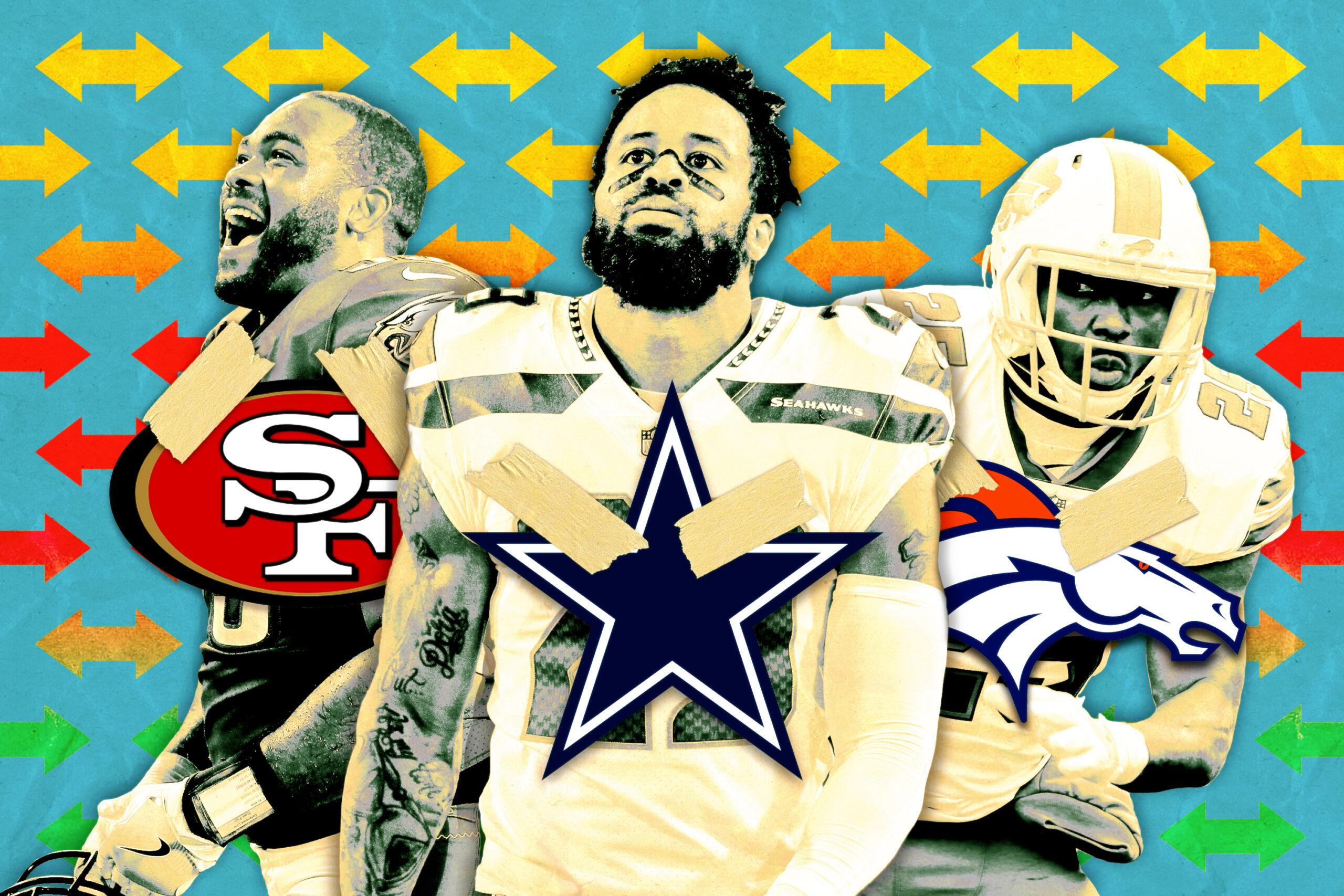
Spurred by the unique combination of an ever-expanding salary cap, the rookie wage scale, the dearth of top-tier free agents, and a little good old-fashioned copycat-itis, we saw an explosion of trades in the NFL this offseason. With teams dealing Alex Smith, Tyrod Taylor, Marcus Peters, Aqib Talib, Brandin Cooks, and Michael Bennett, the NFL proved more willing than ever to wade into the trade market—even with some big-name stars.
Now that the dust has settled from OTAs and mandatory minicamps, and decision-makers have a little extra free time to dig into practice tape, depth charts and salary-cap models—plus work the phones mining for potential partners—it’s possible we see a few more trades before the season kicks off. Predicting specific partners and parameters is just about impossible, but we’re in the offseason dead zone, and it’s fun, so I put together a list of a few trades that could make sense. And keeping in line with the theme of the offseason, it includes some pretty big names.
FS Earl Thomas, Seahawks → Cowboys
Let’s just get the most obvious one out of the way. These two teams were reportedly close to making a trade during the draft, and with Thomas—who’s set to enter the final year of his four-year, $40 million contract—now holding out for a new deal, there’s plenty of reason to believe the option is still on the table. With Byron Jones moving to corner, Dallas needs help in the back end of their defense (which, by the way, is being run in part by former Seahawks defensive coordinator Kris Richard); and Thomas, a native of Texas who grew up a Cowboys fan, apparently wants to play there. There’s little indication that Seahawks GM John Schneider and head coach Pete Carroll are ready to make the 29-year-old the highest-paid player at his position (especially in this year’s strangely-depressed safety market), so a split may be inevitable.
In the short term, trading an All-Pro centerfielder would hurt the Seahawks. But if they’re dead set against giving Thomas that big-money extension, and the Cowboys were to offer up a 2019 second-round pick (or more), Seattle might jump at the opportunity to add some valuable draft capital. The Seahawks would lose out on the star free safety’s services this season, but they’d be getting more than any potential compensatory pick Thomas would yield in 2020 after leaving in free agency.
RB LeSean McCoy, Bills → Broncos
McCoy would likely have to demand a trade for a deal this big to go down, and he’s shown no indication of doing that. Regardless, this trade would give the Bills an opportunity to pull the rest of the proverbial Band-Aid off: They’ve already reset at quarterback and dealt Taylor away while signing A.J. McCarron and moving up to draft Josh Allen. The offensive line is a question mark with the departures of Cordy Glenn, Eric Wood, and Richie Incognito. The receivers group is probably the worst in the NFL. Buffalo—at least on offense—is in rebuild mode. And Shady, who is set to count $8.9 million against the cap this year and $9 million in 2019—is not getting any younger or cheaper, nor will he likely ever have more value.
If the Bills want to free up some cap space and add a long-term building block or two in the form of 2019 draft picks, trading McCoy gives them the opportunity to do so—and it’d be nice of them to send the veteran to a contender. Enter the never-afraid-to-be-bold John Elway. After C.J. Anderson’s release, Denver’s backfield is in flux: Devontae Booker has shown flashes of talent, but has struggled with consistency and injury, while it’s impossible to know what to expect from rookie Royce Freeman. A dynamic, versatile, and tackle-breaking talent like McCoy could give the team’s new quarterback Case Keenum a major boost, both on the ground and in the air—and he’d certainly help cover up some of the flaws of the team’s offensive line. Denver’s defense is still strong, but with Keenum and McCoy in the mix, the offense could finally start to pull its own weight.
DE Brandon Graham, Eagles → 49ers
Let’s say, just for a minute, that the cap-strapped defending champs decide they can’t afford to sign Graham, 30, to a long-term contract extension now or in 2019. In that case, their next two options are to (1) ride out the final year of his contract and maximize their shot at winning a second consecutive title before letting him walk in free agency—thus getting relatively little (a 2020 comp pick, maximum) in return or (2) think big picture, and trade him now for high-value picks and some much-needed cap relief.
I know what I’d do (Super Bowl LIII or bust, baby), but with the 25-year-old Carson Wentz locked in as their franchise quarterback, the Eagles brass should be thinking about the long-term health of their roster and salary cap, too. That’s where the 49ers—cap- and draft-pick rich and not afraid to make a big splash—come in. San Francisco’s got plenty of interior pass-rush talent, but they don’t have a proven elite edge rusher like Graham. If they threw a 2019 second-rounder and more Philly’s way, Howie Roseman may have to consider it.
DL Arik Armstead, 49ers → Browns
Graham deal or not, it wouldn’t be a big surprise if the 49ers make some calls about Armstead in the next couple of months. The 2015 first-rounder has bulked up to play the “big end” spot on San Francisco’s defense this year, but he’s much more effective—and at 6-foot-7, 292 pounds, more physically suited to play—on the inside. Yet next to DeForest Buckner, Solomon Thomas, Earl Mitchell, and Sheldon Day, Armstead is redundant, and heading into his contract year (on a team-exercised fifth-year option) it looks unlikely that the Niners will sign him to a long-term extension.
The Browns, another cap- and draft capital-rich squad, could make for an interesting trade partner. While building out depth and talent at the edge rusher, linebacker, and cornerback spots during the past couple of years, they’re still light on interior pass rushers. Put Armstead on a line with Myles Garrett, Emmanuel Ogbah, and Larry Ogunjobi, and Cleveland’s defense could really make a jump.
DE Dante Fowler, Jaguars → Rams
Fowler grabbed eight sacks and two forced fumbles last year in a rotational role for the Jags—but he’s stuck behind Calais Campbell and Yannick Ngakoue on the team’s depth chart, and after Jacksonville declined to pick up the former third-overall pick’s fifth-year option, his future is up in the air.
The Rams meanwhile, have a major shortage of edge-rushing talent. They’ve done plenty to upgrade their secondary (trading for Talib and Peters, franchise-tagging Lamarcus Joyner, and re-signing Nickell Robey-Coleman) and interior pass rush capability (signing Ndamukong Suh) but after trading away Robert Quinn, they need to restock the shelves at defensive end. L.A. would have to do a little bit of cap juggling to get Fowler and stay under the cap (he’s set to count $7.4 million against the cap, while the Rams have just over $2 million in space)—but he’d be another nice addition to L.A.’s “win-now, worry about the roster later” strategy for 2018. In theory, if Fowler produces, the Rams would have the long-term cap space potential to sign him to a contract extension, too.
DE Carlos Dunlap, Bengals → Panthers
The Bengals have a decision to make on Dunlap’s future with the team. The 29-year-old pass rusher heads into his contract year coming off a 7.5-sack campaign, and while there’s reportedly progress being made to get an extension done, Cincy invested heavily at the position over the past couple of drafts and have Carl Lawson, Jordan Willis, and rookie Sam Hubbard waiting in the wings.
The Panthers could make for a logical trade partner. Carolina does not have the same caliber of pass-rush farm system to rely on, and they’re putting an awful lot of stock in Mario Addison and 38-year-old Julius Peppers to provide consistent pressure off the edge this year. If that squad hopes to get after the likes of Drew Brees and Matt Ryan they’d be behooved to add another veteran pass rusher.
RB Ameer Abdullah, Lions → Texans
Abdullah heads into the season behind free agent LeGarrette Blount, rookie Kerryon Johnson, and veteran pass catcher Theo Riddick. A mid- to later-round pick might be enough for former Patriots offensive coordinator Bill O’Brien to pluck Abdullah from former Patriots defensive coordinator Matt Patricia. Houston is in need of some depth at the position as recent reports indicate that the early part of second-year back D’Onta Foreman’s season may be in doubt as he comes back from an Achilles tendon tear. Abdullah is a dynamic athlete with plenty of burst in space, and could be a perfect fit in O’Brien’s motion-heavy, hybrid-spread scheme.
TE Maxx Williams, Ravens → Chargers
The Ravens just took two tight ends in the draft (Hayden Hurst in the first round and Mark Andrews in the third). Williams is heading into his contract year and is unlikely to stick long term with the team that drafted him. The Chargers, meanwhile, just lost Hunter Henry to an Achilles tear and don’t have much depth outside of Virgil Green (as long as Antonio Gates, 38, remains unsigned). This would be anything but a blockbuster move, but Williams could give L.A. a little more experience at the position and provide Philip Rivers with another big target over the middle of the field.
OLB Shane Ray, Broncos → Titans
Ray just had his fifth-year option declined, is set to back-up rookie Bradley Chubb, and just had another surgery on his wrist (which could keep him out at the start of the year). When he gets back, he may find himself behind Shaquil Barrett on the team’s 2019 free-agent priority list. At this point, a change of scenery may be for the best, and the Titans, under defensive coordinator Dean Pees, could be a good place to start anew.
Ray’s not a big ticket, instant impact starter, but when he returns to the field, he could provide some much needed insurance for a questionable Tennessee outside linebackers group with starters Brian Orakpo and Derrick Morgan. Kevin Dodd may be on his last chance with the team, Aaron Wallace is coming off a back injury, and rookie Harold Landry could need a little time to acclimate to the NFL. Ray posted eight sacks in 2016, so the potential for production is there. It just might not be in Denver.

